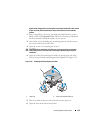
116 Installing System Components
System Memory
Your system supports DDR3 registered DIMMs (RDIMMs) or unbuffered
ECC DIMMs (UDIMMs). Single and dual-rank DIMMs can be 1067- or
1333-MHz, and quad-rank DIMMs can be 1067-MHz.
The system contains 12 memory sockets split into two sets of six sockets, one
set per each processor. Each six-socket set is organized into three channels of
two memory sockets per channel. The first socket of each channel is marked
with white release levers.
The maximum memory that is supported on your system varies according to
the types and sizes of memory modules being used:
• RDIMMs of sizes 2-GB, 4-GB, and 8-GB are supported for a total of up
to 96 GB.
• 1-GB and 2-GB UDIMMs are supported for a total of up to 24 GB.
General Memory Module Installation Guidelines
To ensure optimal performance of your system, observe the following general
guidelines when configuring your system memory.
NOTE: Memory configurations that fail to observe these guidelines can prevent
your system from starting and producing any video output.
• RDIMMs and UDIMMs cannot be mixed.
• In a dual-processor configuration, the memory configuration for each
processor must be identical
• For Optimizer Mode, memory modules are installed in the numeric order
of the sockets beginning with A1 or B1.
• For Memory Mirroring or Advanced ECC Mode, the three sockets furthest
from the processor are unused and memory modules are installed
beginning with socket A2 or B2 and proceeding in the following order: A2,
A3, A5, and A6).
• Advanced ECC Mode requires x4 or x8 DRAM device widths.
• The memory speed of each channel depends on the memory
configuration:
– For single or dual-rank memory modules:
• One memory module per channel supports up to 1333 MHz.


















